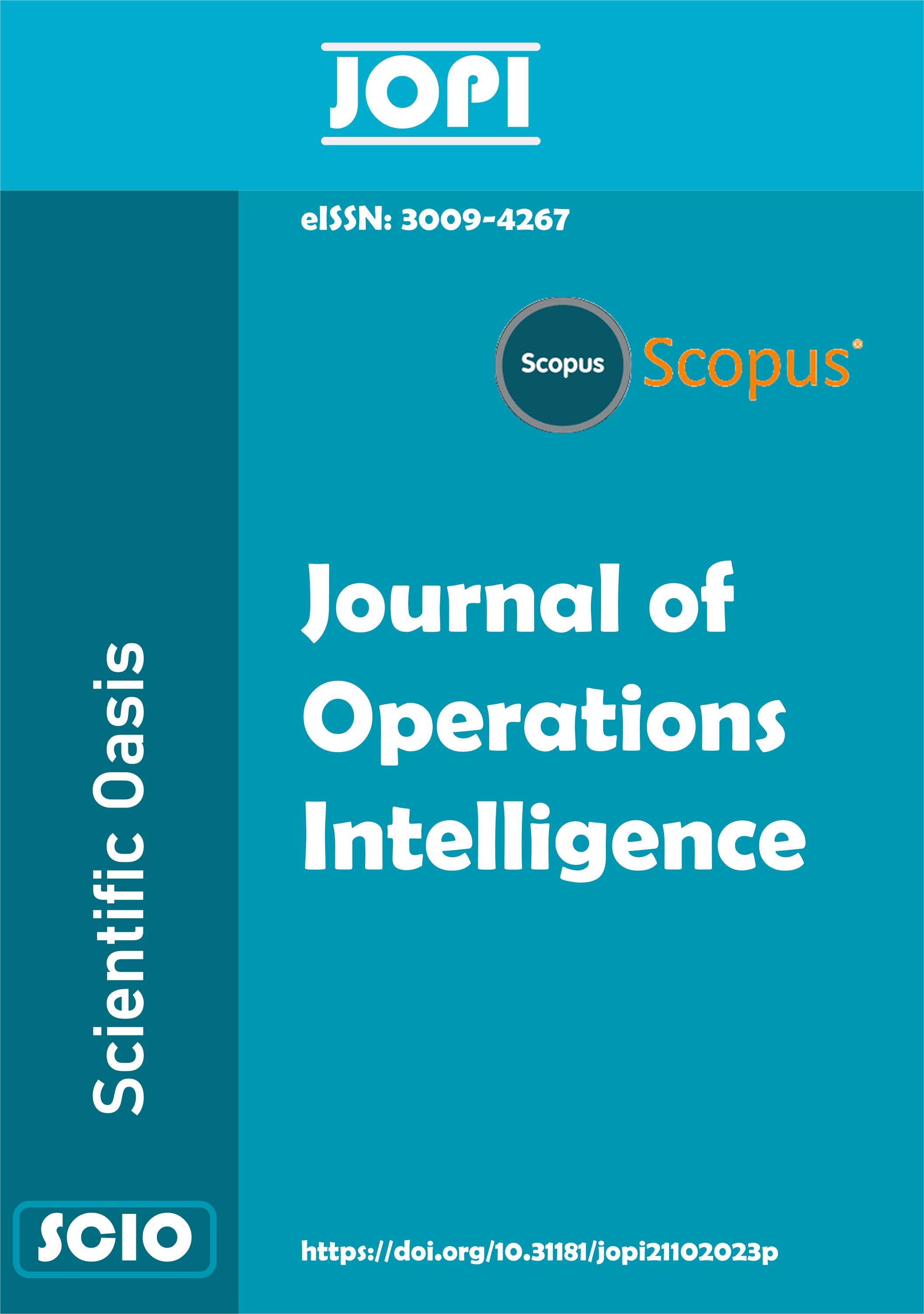Optimization of Stowage Strategy for Ship Loading Tasks
DOI:
https://doi.org/10.31181/jopi21202425Keywords:
Ship Stowage, Bin Packing Problem, Optimization AlgorithmAbstract
In recent years, the logistics industry has witnessed rapid growth, drawing considerable attention to pre-transport cargo loading as a focal point of research for scholars globally. However, the escalating complexity of actual transportation processes and the diversification of application scenarios have rendered traditional loading methodologies inadequate to meet the evolving demands of enterprises. To address this issue, this paper presents a solution to the loading problem of rectangular pulp bales in non-rectangular complex cargo holds, effectively meeting the demand for optimization algorithms and thereby conserving manpower and resources. The paper introduces a packing algorithm tailored to custom regions, which integrates the optimized Skyline algorithm with domain-search iterative strategies to achieve optimal loading outcomes. Furthermore, the efficacy of the algorithm is validated using real maritime data, demonstrating its robust performance and loading efficiency.
Downloads
References
Garey, M. R., & Johnson, D. S. (1981). Approximation algorithms for bin packing problems: A survey. In Analysis and design of algorithms in combinatorial optimization (pp. 147-172). Vienna: Springer Vienna. https://doi.org/10.31181/dmame181221015k.
Garey, M. R., & Johnson, D. S. (1990). A Guide to the Theory of NP-Completeness. Computers and intractability, 37-79. https://doi.org/10.1137/1024022
Fleszar, K. (2022). A MILP model and two heuristics for the bin packing problem with conflicts and item fragmentation. European Journal of Operational Research, 303(1), 37-53. https://doi.org/10.1016/j.ejor.2022.02.014
Martello, S., & Vigo, D. (1998). Exact solution of the two-dimensional finite bin packing problem. Management science, 44(3), 388-399. https://doi.org/10.1287/mnsc.44.3.388
Lesh, N., Marks, J., McMahon, A., & Mitzenmacher, M. (2004). Exhaustive approaches to 2D rectangular perfect packings. Information Processing Letters, 90(1), 7-14. https://doi.org/10.1016/j.ipl.2004.01.006
Wei, L., Oon, W. C., Zhu, W., & Lim, A. (2013). A goal-driven approach to the 2D bin packing and variable-sized bin packing problems. European Journal of Operational Research, 224(1), 110-121. https://doi.org/10.1016/j.ejor.2012.08.005
Baker, B. S., Coffman, Jr, E. G., & Rivest, R. L. (1980). Orthogonal packings in two dimensions. SIAM Journal on computing, 9(4), 846-855. https://doi.org/10.1137/0209064
Berkey, J. O., & Wang, P. Y. (1987). Two-dimensional finite bin-packing algorithms. Journal of the operational research society, 38, 423-429. https://doi.org/10.2307/2582731
Burke, E. K., Kendall, G., & Whitwell, G. (2004). A new placement heuristic for the orthogonal stock-cutting problem. Operations Research, 52(4), 655-671. https://doi.org/10.1287/opre.1040.0109
Coffman, Jr, E. G., Garey, M. R., Johnson, D. S., & Tarjan, R. E. (1980). Performance bounds for level-oriented two-dimensional packing algorithms. SIAM Journal on Computing, 9(4), 808-826. https://doi.org/10.1137/0209062
Jylänki, J. (2010). A thousand ways to pack the bin-a practical approach to two-dimensional rectangle bin packing. retrived from http://clb. demon. fi/files/RectangleBinPack. pdf.
Naamad, A., Lee, D. T., & Hsu, W. L. (1984). On the maximum empty rectangle problem. Discrete Applied Mathematics, 8(3), 267-277. https://doi.org/10.1016/0166-218X(84)90124-0
Wei, L., Zhang, D., & Chen, Q. (2009). A least wasted first heuristic algorithm for the rectangular packing problem. Computers & Operations Research, 36(5), 1608-1614. https://doi.org/10.1016/j.cor.2008.03.004
Bortfeldt, A., & Wäscher, G. (2013). Constraints in container loading–A state-of-the-art review. European Journal of Operational Research, 229(1), 1-20. https://doi.org/10.1016/j.ejor.2012.12.006
Gehring, H. (1997). A genetic algorithm for solving the container loading problem. International transactions in operational research, 4(5-6), 401-418. https://doi.org/10.1016/S0969-6016(97)00033-6
Terno, J., Scheithauer, G., Sommerweiß, U., & Riehme, J. (2000). An efficient approach for the multi-pallet loading problem. European Journal of Operational Research, 123(2), 372-381. https://doi.org/10.1016/S0377-2217(99)00263-5
Chan, F. T., Bhagwat, R., Kumar, N., Tiwari, M. K., & Lam, P. (2006). Development of a decision support system for air-cargo pallets loading problem: A case study. Expert Systems with Applications, 31(3), 472-485. https://doi.org/10.1016/j.eswa.2005.09.057
Bischoff, E. E. (2006). Three-dimensional packing of items with limited load bearing strength. European Journal of Operational Research, 168(3), 952-966. https://doi.org/10.1016/j.ejor.2004.04.037
Bischoff, E. E., & Ratcliff, M. S. W. (1995). Loading multiple pallets. Journal of the Operational Research Society, 46, 1322-1336. https://doi.org/10.1057/jors.1995.181
Ren, J., Tian, Y., & Sawaragi, T. (2011). A tree search method for the container loading problem with shipment priority. European Journal of Operational Research, 214(3), 526-535. https://doi.org/10.1016/j.ejor.2011.04.025
Bortfeldt, A., & Gehring, H. (1999). Zur Behandlung von Restriktionen bei der Stauraumoptimierung am Beispiel eines genetischen Algorithmus für das Containerbeladeproblem. Logistik Management: Intelligente I+ K Technologien, 83-100. https://doi.org/10.1007/978-3-642-60184-2_8
Hodgson, T. J. (1982). A combined approach to the pallet loading problem. IIE Transactions, 14(3), 175-182. https://doi.org/10.1080/05695558208975057
Haessler, R. W., & Talbot, F. B. (1990). Load planning for shipments of low density products. European Journal of Operational Research, 44(2), 289-299. https://doi.org/10.1016/0377-2217(90)90364-H
Bortfeldt, A., & Gehring, H. (2001). A hybrid genetic algorithm for the container loading problem. European Journal of Operational Research, 131(1), 143-161. https://doi.org/10.1016/S0377-2217(00)00055-2
Downloads
Published
Issue
Section
License
Copyright (c) 2024 Zhuangle Yao, Lubin Wu, Meng Yuan, Zehui Wu, Shancheng Jiang, Zhen-Song Chen (Author)

This work is licensed under a Creative Commons Attribution 4.0 International License.





















